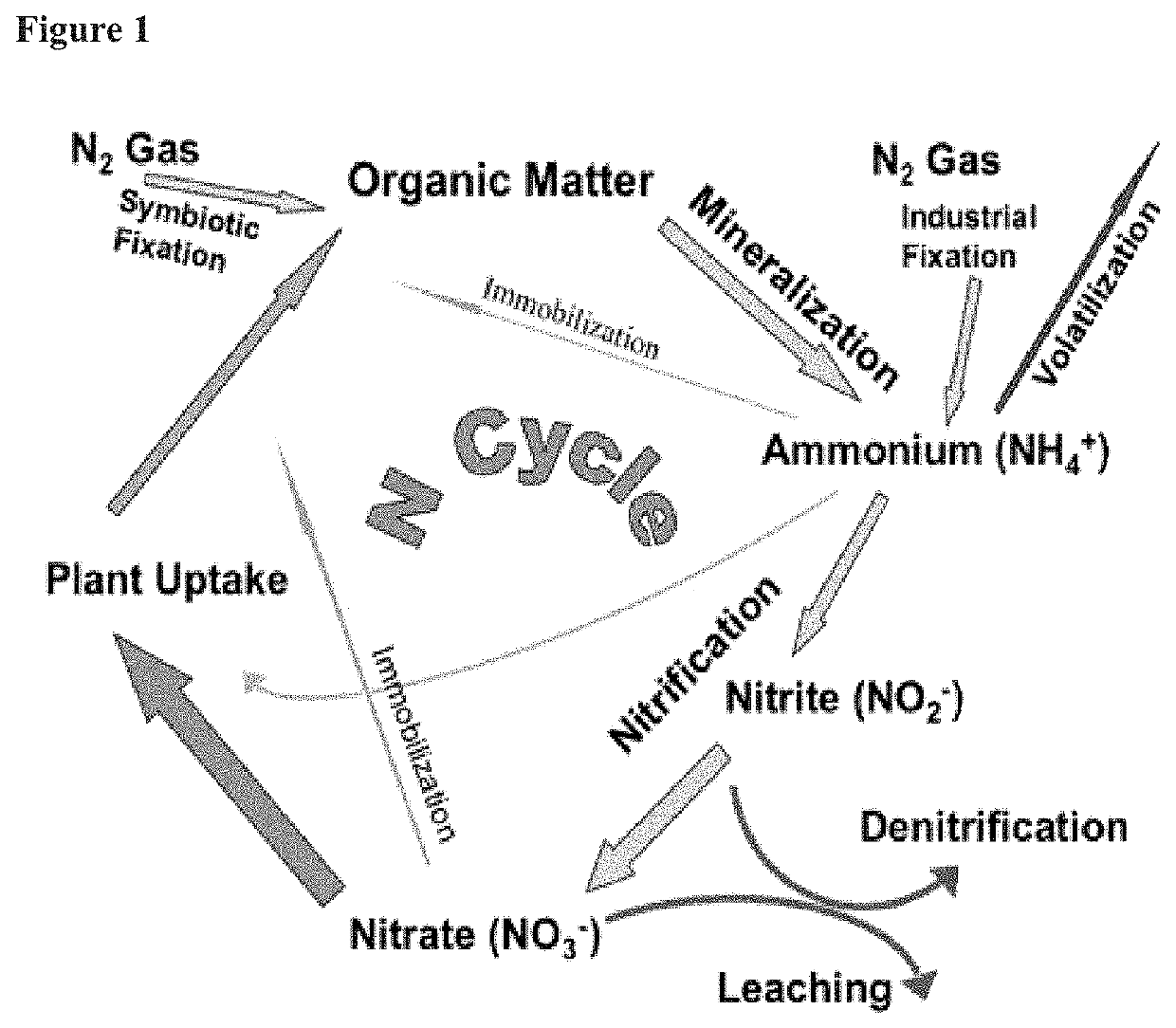Nitrogen fertilizer bio-catalyst for sustainable crop production
a technology of nitrogen fertilizer and biocatalyst, which is applied in the direction of biocide, microorganisms, bacteria based processes, etc., can solve the problems of overgrowth of bacteria and fungi, high environmental cost, and limited food production, and achieve the effect of increasing the efficacy of synthetic fertilizers and cost-effectiveness
- Summary
- Abstract
- Description
- Claims
- Application Information
AI Technical Summary
Benefits of technology
Problems solved by technology
Method used
Image
Examples
example 1
ENDOPHYTIC BACTERIA FROM FRESH PLANT SAMPLES
[0100]Fresh samples of corn, Sorghum, and sugarcane plants were acquired and washed in tap water. The roots and shoots from each plant was separated. The roots and shoots were separated and chopped. They were then surface sterilized to eliminate any epiphytic bacteria and to facilitate isolation of only endophytic bacteria. The samples were then ground to isolate endophytic bacteria. Endophytic bacteria isolated from corn plants included T4, T6, and C8. Endophytic bacteria isolated from Sorghum plants included J-1, J-2 / 1, J-2 / 2 (BMS-101, NRRL accession # B-67826), J-3 / 1, J-3 / 2, J-3 / 3, and J-4. Endophytic bacteria isolated from sugarcane plants included S-1 / 1, S-1 / 2, S-5, S-7, and S-8.
example 2
IZING ACID AND ALKALINE PROTEASE PRODUCTION FROM THE ISOLATED ENDOPHYTIC BACTERIA
[0102]Protease activity was determined using the modified Anson method as described in Hashimoto et al., (1973). Briefly, reaction mixture was prepared by combining 1 ml of enzyme solution and 5 ml of bovine casein in 0.05 M acetate buffer (pH 2.5) and incubated at 30 degree C. for 10 minutes. Five ml of 0.11 M trichloroacetic acid was added to stop the reaction. The reaction mixtures was filtered after incubation at 30 degree C. for 30 minutes. Five ml of 0.55 M sodium carbonate was added to 2 ml of the filtrate followed by the addition of 1 ml of thrice diluted phenol reagent. Acid protease activity exuded by endophytic bacteria was quantified based on the concentration of tyrosine measured at 660 nm.
[0103]Alkaline Protease Assay:
[0104]Alkaline protease activity was determined according to the procedure of Smita et al., (2012). The assay medium (50 ml) containing nutrient bro...
example 3
NOCULATION EFFICACY OF ENDOPHYTIC BACTERIA
[0108]The inoculum for endophytic bacteria was grown under controlled conditions for 48 hrs to inoculum density of 108 to 1010 cfu / ml. The inoculum was centrifuged and suspended in sterile PBS to a concentration of 108 cfu / ml. The seeds were surface sterilized with 95% ethanol for 2 min and 2.5% sodium hypochlorite for 20-30 min followed by washing seven times in sterile water. Surface sterilized seeds were soaked in sterile PBS containing endophytic bacteria and placed in a temperature controlled incubator shaker at 25 degree C. for exactly 30 minutes. The inoculated seeds were washed with 70% alcohol for 2 minutes and with 2% sodium hypochlorite followed by washing with sterile water 5 times. The surface sterilized seeds were placed in sterile petriplates containing 0.7% of water agar, 5-10 seeds per plate. The seed containing plates were transferred to growth chamber set at 30 degree C. and left for 48 hours to germinate. Well germinated ...
PUM
| Property | Measurement | Unit |
|---|---|---|
| pH | aaaaa | aaaaa |
| pH | aaaaa | aaaaa |
| density | aaaaa | aaaaa |
Abstract
Description
Claims
Application Information
 Login to View More
Login to View More - R&D
- Intellectual Property
- Life Sciences
- Materials
- Tech Scout
- Unparalleled Data Quality
- Higher Quality Content
- 60% Fewer Hallucinations
Browse by: Latest US Patents, China's latest patents, Technical Efficacy Thesaurus, Application Domain, Technology Topic, Popular Technical Reports.
© 2025 PatSnap. All rights reserved.Legal|Privacy policy|Modern Slavery Act Transparency Statement|Sitemap|About US| Contact US: help@patsnap.com



